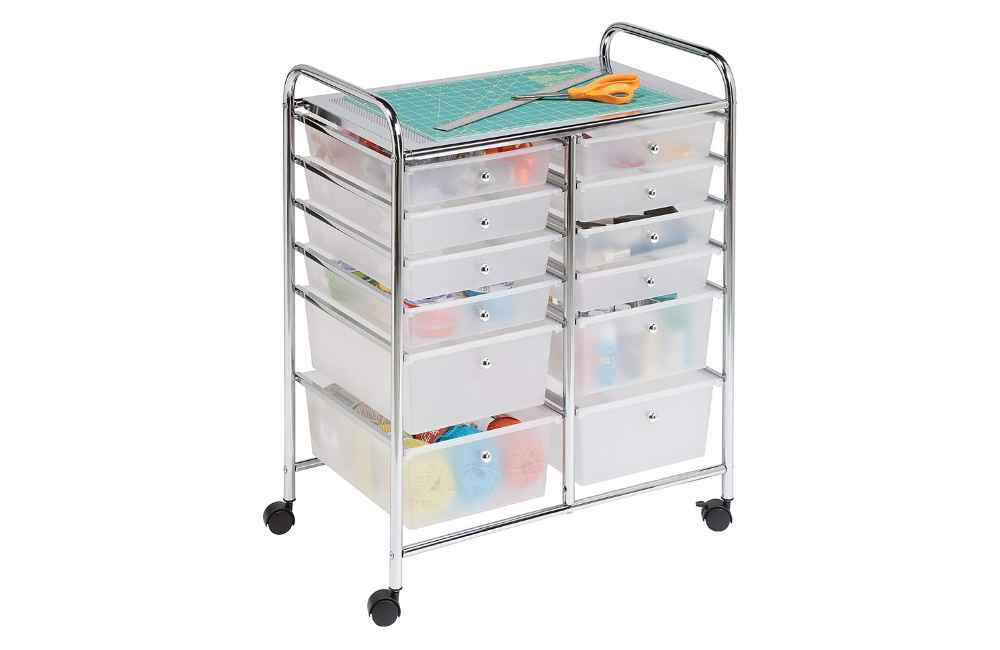Jewelry making is a creative and rewarding craft, but it can quickly become frustrating if your tools are disorganized and difficult to find. Keeping your space orderly and having a system of organization in place can help you focus on the enjoyable and wonderfully creative aspects of jewelry design.
We'll look over organizing strategies that will keep your jewelry making tools organized and your workspace tidy and productive. Whether you're a beginner or an experienced artisan, this user-friendly guide will help streamline your creative process and optimize your craft room storage for your tools.
How to Organize Jewelry Making Tools?
1. Mugs and Cups (Free!)
A quick and easy solution to keep your equipment organized is to repurpose your cups or mugs for tool storage when crafting jewelry. Choose a cup or mug that matches your personal taste and make sure the opening is big enough to hold the biggest tool you intend to store.
To make it easier for you to instantly recognize your tools, you can decorate or label the mug instead of leaving it plain. Stickers are an excellent option (unleash your inner toddler!).
Once you've chosen and decorated your mug, put it on the work table to use for small equipment storage, like tweezers and bead reamers. It will instantly give your workspace some personality and make sure your small tools are always within reach.

Pro Tip:
Redbubble offers an incredible collection of stickers from artists - choose ones for your mug that make you smile, laugh or inspire creativity.
2. Pegboards
Pegboards are a versatile and customizable option for organizing your jewelry tools. They can be organized to suit your particular needs and give enough storage space for a variety of tools since they can be fitted with hooks, baskets, and shelves.
Pegboards are wall mounted and a vertical storage solution. They help save valuable desk space by keeping jewelry making tools off the table. Pegboards can also minimize table clutter and create a more organized and tidy workspace.
One of the many advantages of having a pegboard is the ease with which you can access your tools, which makes for a more productive designer (that's you!). This is especially helpful if you need to access a sizable tool collection. Keep your frequently used tools within easy reach, like chain nose and round nose pliers, and store the less frequently used ones farther away on the pegboard.
You can change the layout and positioning of your tools as needed. Since they're modular, pegboards can be easily adapted to accommodate new jewelry tools and different sized ones.

3. Tool Chest or Tool Box
Investing in a tool chest or tool box is a practical solution for jewelry makers. Not only does it provide ample space for storage, but it also protects your tools from dust, damage, and loss.
Additionally, a tool box for smaller handheld jewelry tools is portable and can be moved around your workspace easily.
Having a system of organization is crucial to keeping your tool box tidy and reducing the risk of misplacing important tools. Keep your most frequently used tools on top, so you do not have to dig for them. Designating specific places for tools like pliers and tweezers, utilizing labels and dividers, and consistently returning items to their proper location after use can all contribute to a well-organized jewelry tool box.
Pro Tip:
When looking for the perfect tool box to store your jewelry making tools, it's worth considering options beyond those marketed for crafts.
Fishing tackle boxes and professional tool chests from hardware stores tend to be of higher quality and offer more storage options, like drawers and dividers.
4. Plier Blocks and Holders
A plier block is one of the best tools for jewelry makers who work with pliers regularly. These holders are designed to keep your pliers organized and easily accessible. They come in different sizes and shapes to accommodate various plier types, such as chain nose, crimping and side cutters.
A plier block can also help prevent damage to your tools by keeping them upright and separated, preventing them from rubbing against each other or getting tangled.

5. Magnetic Strip
A magnetic strip is a straightforward and efficient way to store your jewelry tools. The magnetic tool bar will hold and organize your pliers, scissors, wire cutters, hammers and other metal tools against the wall or other flat surfaces. Tools are held securely, yet will release with a gentle tug.
One of the major benefits is that this is a vertical storage solution that removes items from your workbench, while also keeping them conveniently accessible. Your tools will always be within reach thanks to the strip, which can be mounted on a nearby wall or work table. It is compact and highly effective.
However, it will only work for metal tools, so you will still need to organize your plastic tools. Additionally, installing the magnetic strip will require putting holes in your wall for screws and anchors.
6. Wooden File Stands
A wooden file stand can be an unconventional yet effective tool organized to handle a wide variety of jewelry-making instruments. Despite the fact that these stands are normally used to store files, they can also be used to store other instruments with comparable dimensions. For instance, a file stand can be used to hold wire cutters, pliers, calipers, or hammers.
Utilizing a file stand has the benefit of keeping your equipment accessible and organized. The stand can be set up on your work surface so that all the necessary tools are close at hand.
7. Portable Travel Case
If you have a limited workspace or frequently travel with your jewelry making tools, a portable travel case or tool pouch is a great option. These carry cases are small, compact, and designed to hold and protect your tools.
The interiors have elastic loops that can safely hold several sets of jewelry pliers and tools. It may feature compartments or pockets to even keep additional small items like jump ring openers.
The cases are made with different durable materials, like leather, vinyl or sturdy fabric, often have a wrap-around zipper to keep your tools safely contained and come in many different sizes. We recommend finding one in your favorite color and personalizing it with fun stickers!
8. Rolling Storage Carts
Rolling storage carts (also called utility carts) are versatile and convenient storage solutions that can be used for organizing jewelry tools. Most carts have multiple levels of storage and spacious drawers to provide additional storage space to hold small handheld tools like pliers, cutters, and tweezers.
You can put your frequently used tools on top of the cart while keeping the less commonly used ones tucked away for storage.
They are mounted on wheels with a push handle, making it easy to move around your workspace. The casters can also be locked in place, ensuring the cart stays in one spot while you work. If your workspace is multi-purpose (for example a dining room table), the cart can be pulled out and then tucked back away when you have finished creating.

9. Tool Rolls
A tool roll is a compact organizer made from heavy-duty fabric, like canvas, that features multiple pockets of various sizes to accommodate different size tools like pliers, wire cutters, crimping tools, tweezers, and more. The best ones have fold-over flaps, durable straps, and buckles, and reinforced stitched pockets to ensure your jewelry tools stay put.
Tool rolls are portable and incredibly practical for designers that need to travel or have a limited workspace. You can neatly arrange your tools in the pockets, access them easily, and then compactly roll it back up when you're done. They are a great low-cost option for hobbyists and professional jewelry makers.
Tips & Tricks from Experts
Now that you have ideas about how to organize your jewelry tools, there are also a lot of additional things you can do to keep your creative workspace clean and tidy (and you actually don't need to spend a lot of money!).
Label Your Containers
Labeling your storage containers is an effective way to quickly locate specific tools and supplies. Label makers, masking tape, or even a permanent marker can be used to label your storage containers. For instance, if you keep all your crimp beads in one container, make a label for this!

Group Similar Tools Together
Grouping similar tools together, such as pliers or tweezers, can help you quickly find what you need and avoid wasting time searching through a cluttered collection.
Keep Your Workspace Clean
We know that keeping your workspace tidy is easier said than done. But having a clean and clutter-free work table ensures you have ample space to work and reduces the risk of misplacing your tools.
Remember to regularly throw away empty bead bags, wire scraps, damaged or defective beads, and other garbage. These small trash items can gradually encroach into your workspace, so get into the habit of discarding them right away.

Use Drawer Dividers or Trays
Drawer dividers or trays can help you keep your tools organized within larger containers, making it easier to find specific items and avoid clutter.

Whether you're new to jewelry making and are setting up your first workspace or are struggling to organize an overly cluttered craft room, you can use the storage solutions in this article to help you put together a thoughtful and well-organized workstation.
Remember, being able to easily find your tools is key to a smooth jewelry making process, so taking the time to make a well-designed workstation can pay off in the long run.

How do you store your jewelry tools?
Tell us in the comments below! 👇



